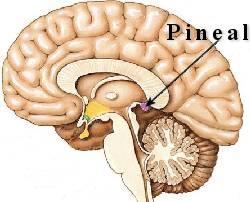The Pineal Gland: An Enigma of the Mind

The pineal gland has always sparked a lot of interest. Descartes said that this tiny gland located right in the center of the brain was the “seat of the soul,” the center that manages all of our thoughts. There are also those who call this little structure our “third eye,” a vortex of energy that allows us to perceive things beyond our sense of vision.
Setting aside these mystical, spiritual and somewhat colorful perspectives, the function of the pineal gland, or the epiphysis cerebri, is both interesting and enigmatic. It regulates our cycles, our circadian rhythm, the onset of puberty, and even a bunch of our feelings. It’s a strange and fascinating structure.
The pineal gland is more than a third eye. It’s a tiny orchestra conductor who’s inspired by the light of the sun, who subtly regulates our cycles, our moments of relaxation, and the onset of puberty.
One of the most interesting aspects of the pineal gland is that, despite being so small (barely 8 mm), it receives an immense flow of blood, almost as much as the kidneys. It’s shaped like a tree, which is where the term “pineal” comes from. The trunk and branches of the tree tend to harden very quickly due to a buildup of calcium. Some calcification can already be seen between 12 and 20 years of age.
Nevertheless, it continues to fulfill many of its essential functions, which we explain below.

The pineal gland: cycle regulator and vestigial eye
The pineal gland is a photosensitive structure, so therefore one of its principal biological functions is to secrete melatonin. This hormone is derived from serotonin, and it regulates the sleep-wake cycle (circadian rhythm) and the onset of puberty.
It acts as a finely-tuned biological clock, with high activity up until 7 or 8 years of age, at which point the production of melatonin starts to decrease and the mechanisms of sexual maturity begin working.
Some studies indicate that this structure is very sensitive to certain environmental chemicals. In some countries, like the United States, girls are reaching puberty very early due to the exposure to certain substances like fluoride.
Despite being embedded right in the center of the brain, the pineal gland is incredibly sensitive to the environment. It’s a tiny biological lighthouse in humans and a vestigial organ in some other animals.
The tuatara, a kind of reptile native to New Zealand, is known for having a “third parietal or pineal eye” right in the center of its head. It has a retina and a lens, and it also fulfills hormonal functions and helps with thermoregulation. How fascinating.

How to take care of this little internal regulator
Neurologists aim to separate the mystical and spiritual from the scientific. The pineal gland is a small structure that we still don’t know much about, which is why journals like the “Journal of Pineal Research” continuously publish studies that aim to measure the scope of its functions. Most people consider the epiphysis cerebri to be a master key that activates most of our internal glands.
The pineal gland is a master key that translates signals from the environment into endocrine responses.
Now you know about this “little inner eye” that secretly regulates the body’s daily cycles. Think of it as a compass, a marvelous little organ that keeps you in tune with your body and your environment.

Taking care of your pineal gland
Here are a few tips to take care of your pineal gland:
- Be regular when it comes to your daily cycles and habits. The pineal gland is a photosensitive endocrine regulator, which means it needs to be in harmony with the rhythms of sunlight. That’s why it’s so important to always go to bed around the same time.
- Avoid electromagnetic fields. Just like light, electromagnetic waves interrupt the process of melatonin secretion. Something as common as using your cellphone or laptop before bed can cause slight alterations in the pineal gland. This can all turn into insomnia, fatigue, stress, and poor performance at work. Keep this in mind.
- Give yourself time to meditate and be calm. The epiphysis cerebri can help you feel more calm and relaxed, which makes it easier to connect with yourself. People who meditate, for example, experience a pleasant sensation because the pineal gland secrets endorphins, rewarding them for those enriching moments where the body and mind are in harmony.
New things are being discovered about the pineal gland each day, so look out for more information!
This text is provided for informational purposes only and does not replace consultation with a professional. If in doubt, consult your specialist.








